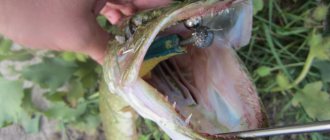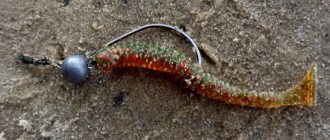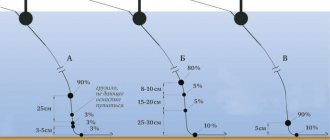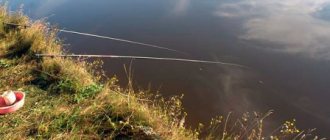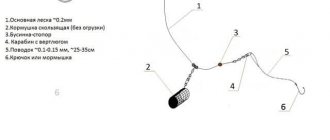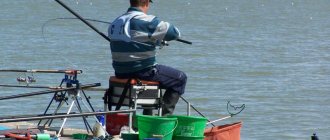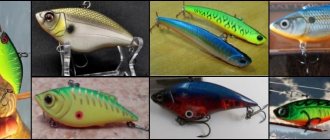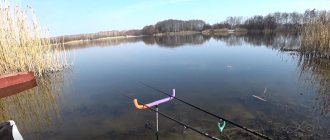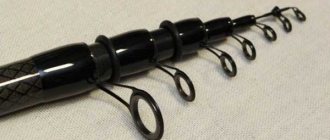Spinning fishing on small rivers and streams is popular due to the prevalence of such reservoirs. All cities in Russia have at least one similar river nearby. When going with a spinning rod along small rivers, it is important to take into account that fishing on them differs from large reservoirs, which leaves an imprint on fishing. One of the features is the need to use small baits, since large specimens are rarely found here, and for small baits it is necessary to use ultralight or light rods.
Features of fishing on small rivers
Content
Spinning fishing on small rivers must take into account the basic rules:
- It is advisable to use fine groundbait in combination with small bait. The reason is not only the size of the average individuals, but also the susceptibility of such reservoirs to active pressure from fishermen. An interesting feature is that a smaller bait is many times more effective than a larger one;
- Due to the small width of the stream, it is better for the spinning angler to use short rods; there is no need for long options, this will only cause inconvenience. It is convenient to fish with an ultralight fishing rod about 2-2.4 m long;
- The melting of ice and warming up of the reservoir occurs much faster, that is, the inhabitants wake up from sleep earlier than in large rivers. Here the season not only begins earlier, but also ends, since the cooling of the water also accelerates;
If during a flood the river connects with large bodies of water, then large individuals may be caught in the river
- The small food supply among the inhabitants of reservoirs causes the frequent capture of small or medium-sized individuals. Trophy specimens come across only to very lucky anglers. More often, large individuals are found in a reservoir if, during a flood, the river connects with large reservoirs;
- Fishermen often go to the reservoir, which causes the absence of a large number of fish. The most compacted rivers are close to the city, as they can be reached by bus. In compacted reservoirs, fish respond well to standard baits for fishing or, on the contrary, avoid them;
- if the promising site is located in a forest, there will be an abundance of snags or many overhanging tree branches at the bottom. This is a good place for fish, as they find shelter in the snags, but the fisherman will need high casting accuracy. We recommend using gear that can be easily replaced in case of a snag. Be sure to use thin fishing line for leashes; you can always tear them off and save the main line;
- Basically, the feeder is not effective, since the depth of the reservoir does not allow the tackle to be lowered deeply. If there are holes at the bottom, bottom gear will be appropriate in them;
- An important feature of shallow rivers is the ability to see prey underwater, but we remember that the fish also sees the fisherman, so camouflage is extremely appropriate.
Length

Small rivers are called small because they are small in size, and in some places you can touch the opposite bank with the tip of a fishing rod. Fishing is carried out both “underfoot” and at some distance from the coastline. The width of the river, its depth and the nature of the flow leaves a certain imprint on the choice of fishing rod. I'll explain now. When fishing in the “jabovnik”, you need to use a not very long, but quite powerful spinning rod that can withstand critical loads.
Why is it preferable to use a short spinning rod? It's simple. Firstly, with a short spinning rod it is more convenient to overcome all kinds of thickets and bushes, which, by the way, are present in abundance on such reservoirs. Secondly, with a short spinning rod it is easier to animate a number of baits that require active animation, for example, a wobbler. Well, and thirdly, on small rivers there is simply no need for a long rod, since there is no need for long casting, and all fishing is done, roughly speaking, closely.
For several years now I have been using only classic bass “pegs” on reservoirs of this type. They are quite loud and powerful. I have a length from 190 to 220 centimeters. And believe me, the length of 220 centimeters is enough for your eyes. Throwing the bait 40-50 meters from the shore (although more often such a long cast is not required at all due to the nature of the reservoir) is quite possible. Most often I fish with a GAD Gancho spinning rod with a length of 198 centimeters and a weight of 10.5 to 32 grams. It is powerful, forgiving of many mistakes, and most importantly, wildly versatile, but we’ll talk about that a little later, and now let’s move on to the test border.
Gear for fishing on small rivers
On small rivers, be sure to take a spinning rod of short length, otherwise you are guaranteed to constantly get caught on branches, creating unnecessary noise and difficulty casting. Experienced fishermen recommend taking models about two meters; the scope of such gear allows for more possibilities and a lower risk of breakage or hooking of the gear. A two-meter spinning rod is enough to fish the center of the river, and usually it is enough to cast bait to the opposite bank.
Read more
How to catch an asp using a bombard?

Spinning rods of short length are used on small rivers
A light spinning rod for small rivers is the most convenient and versatile option, as it allows you to hunt almost all fish in the river. When choosing gear, it is better to take one with a test weight of up to 20 g. There are also fans of ultralight, their preferred test rod is up to 5 g. A classic spinning rod does not require special rods, but when installing feeders, you will have to take options with a larger test.
The best action in such conditions is super-fast or fast, with their help it is easier to carry out a variety of postings of any baits. Their additional advantage is high casting accuracy, this is especially important due to the numerous obstacles in small bodies of water. The disadvantage is that it is somewhat difficult to catch prey in comparison with slow and medium formations, but this is a forced sacrifice.
The design of the handle is an important parameter of the fishing rod; in small bodies of water it is convenient to use a short monolithic handle. A blank like this makes it easier to cast with one hand. Ultralight fishing rods are often designed with a spaced handle; this is done to reduce the weight of the structure; they are suitable for our purposes.
If you plan to fish with a jig, we recommend using a special spinning rod - area fishing, originally intended for fishing in paid reservoirs. Alternative options are trout fishing rods adapted for fishing on fast rivers. The peculiarities of using jigs determine the need for specific fishing techniques and tactics. We recommend taking these rods up to two meters in length with 3 g of dough and a slow action.
For reels, we can use multiplier models, but inertialess options are easier for a novice fisherman to master and, in general, they are more convenient to use. Multipliers are suitable for testing rods from 10 g, as they provide better sensitivity and control of the equipment. Coils of sizes 1000 and 2000 are comfortable for ultralight, and 2000-3000 are suitable for light, although 4000 are sometimes used, but for specific tasks.
Regarding float and spinning light tackle for fishing on streams, we can choose budget options; their reliability is acceptable for the task at hand. When fishing with high-quality models, ultralight rods and reels will be expensive, and Chinese options lead to frequent breakdowns.
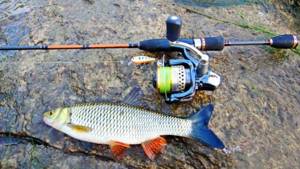
Superfast or fast action is best in such conditions
fishing line
Oddly enough, it is also a very important part of the gear. We will not recommend this or that type of forest; we will let you decide for yourself which type will be closer to you, but it is still worth telling about the properties of each type of forest.
Mono line. Elastic: during fishing, it absorbs particularly strong jerks of the fish. High resistance to abrasion, this is especially important when fishing on rapids, when the line constantly comes into contact with underwater rocks. It is transparent in the water, I already mentioned above the timidity of fish, so a mono thread, especially the thinnest diameter, is invisible in the water, therefore, the fish will take the bait without fear. The low coefficient of friction allows for fairly long casting with ultra-light lures. Mono fishing line does not absorb water, and in frosty weather the forest does not freeze, which makes fishing much easier. It should be remembered that the smaller the diameter of the line, the better small baits work.

Braided line: first of all, it should be noted the high breaking load; when hooked, this allows you to unbend the hooks of small baits and preserve them. Lack of longitudinal extensibility; when fishing, the entire load falls only on the spinning rod and the reel clutch. The high coefficient of friction, and therefore the casting distance with ultra-light baits, will be inferior to mono fishing line. It absorbs water and abrasive particles, which is why the effect of “sawing through” the rings and roller occurs. At negative temperatures, the cord, and, consequently, the rings with the roller will freeze. Since the cord of the first generations does not have a round cross-section and therefore sails in strong winds, casting accuracy may suffer from this. At the same time, the cord is highly sensitive, which is especially necessary when jig fishing.
Not long ago, a new type of braid appeared on the market - polyethylene cord with the PE brand. Polyethylene cord carries the positive properties of both regular braid and mono fishing line. It has a low coefficient of friction and precise compliance with the cord diameter. The breaking load is lower than that of a regular cord, although it is stronger than mono thread. The main thing is that it does not lose strength characteristics. Practically does not absorb water and abrasive particles, therefore, does not saw through rings and rollers. It polishes itself as it passes through the rings, reaching almost the state of a mono thread.
Now a few words about the recommended diameter of the line. It is more convenient to have two or three spools with lines of different diameters. The diameter primarily depends on the activity of the fish. In summer, when the water level is low and transparency is high, a thicker line will be noticeable in the water. For such cases, it would be logical to use a spool with a line of 0.14-0.18 mm. The same spool can be used during weak bites, using light baits. In autumn and spring, during floods and rains, when the water level is quite high and the predator is active and less careful, it is better to use 0.18-0.22 mm line. A third spool with a cord will allow you to save some of the bait; you can use it when fishing for pike or on heavily snag waters, this will allow you to save some of the bait. The diameter of the cord depends on the baits used, in general, the thinner the better.
In the next issue we will talk in detail about baits used on small rivers, and consider the advantages and disadvantages of different types of baits.
Installation of spinning equipment for small rivers
Small bodies of water open up wide horizons for the fisherman to choose how to mount bait.
Common installations:
- standard jig. It has limited mobility of the nozzle, but is simple to install and easy to learn;
- using an eared sinker. Allows the bait to move more easily in the water;
- drop shot. The main difference is the installation of the sinker and hook directly to the main fishing line. We place a sinker at the very end, and place the hook with bait a little higher. It is most popular when fishing from a boat in deep holes, because it ensures stable play of the bait with virtually no displacement;
- layering. Reminiscent of the previous installation method, but differs by attaching the hook to the leash, and not to the base;
- Carolina rig. Gives good mobility to the bait, but has a high risk of snagging and is used only on a relatively clean bottom;
- Texas rig. It is based on an offset hook with a special sinker. The listed features contribute to increased bait permeability;
- veki is an actively spreading equipment; its main difference is the fixation of a large silicone worm to the central part of the bait. The method is interesting because it provides an interesting game on the current.
Important! When choosing leashes, it is important to give preference to strength and invisibility, but the emphasis on the first or second parameter depends on the type of fish. It is preferable to use metal options for pike, but for other species of reservoir inhabitants, fluorocarbon is a universal material.
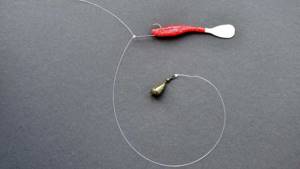
Drop shot is popular when fishing from a boat in deep holes.
Selection of baits for use on small rivers
All fish have their own taste preferences due to their lifestyle. The taste is influenced by the pressure of the river and the food supply (insects in trees, grasshoppers and dragonflies in meadows, small fish everywhere).
Read more
Which fishing line to choose for spinning?
The choice comes down to:
- rotators;
- oscillating spoons;
- wobblers;
- food grade silicone;
- spinnerbaits;
- jigs.
When exploring a body of water, we take with us the largest number of baits available. We experimentally determine the best colors, shapes and types of bait. The only general condition for all types is that there is no point in installing large nozzles.
Features of spinning fishing on small rivers
Effective spinning fishing on small rivers implies a preliminary study of the conditions of the reservoir. It makes no sense to put plant baits if there are no omnivorous or peaceful fish in the river. The fisherman's only catch will be small fry, which are best released. You also need to be careful with animal baits; too large baits scare the fish, and small baits attract high water, which prevents you from catching worthy prey. The right tactics, combined with an understanding of the peculiarities of wiring, are the key to a good catch.
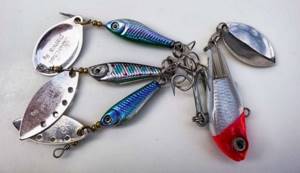
There is no point in placing large baits on small rivers
To avoid wasting time, it is better to first talk with local residents and get to know the inhabitants of the reservoir.
Spinning fishing in winter on small rivers begins earlier than on large reservoirs, but in the event of severe frosts, the fish become extremely passive and do not bite the bait well. The only way to get a good catch is to find a hole, there will probably be fish in it.
Fishing technique
There is nothing difficult in identifying promising fishing spots on most streams, since many fish prefer the same places.
Finding promising fishing spots on a small river is quite easy. First of all this:
- channel turns. Here there are pits in which large fish wait for food to be washed away by the current. There are a lot of predator ambushes around the turn; you can catch a lot of fish with a spinning rod;
- areas with reverse flow;
- underwater vegetation. Wiring along reeds, water lilies, and algae often leads to bites;
- riffles. They are a favorite habitat for chub.
Fishing on small rivers with an ultralight spinning rod can be planned even at home. Having a topographic map in hand, a fisherman can actually plan a route and find the most catching places.
Important! Even in a promising place, it will not be possible to achieve a catch if you ignore camouflage. The fish, noticing a person, leaves the feeding area and goes to a safe place.
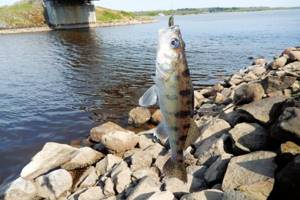
It’s quite easy to find promising fishing spots on a small river
Wiring Features
It is impossible to count the number of methods for guiding a spinning rod; a separate wiring method has been developed for each type of attachment. The simplest method is required when using spinners; it is enough to move them smoothly or with slight delays. The rest of the baits are animated in different ways, so wobblers are suitable for uniform, jerky movements, and are also performed with delays.
Read more
How to catch asp using a spinning rod?
To animate silicone baits, it is advisable to use:
- standard, stepped wiring for jigs;
- pulling the bait with periodic stopping and raising the bait using the top of the fishing rod;
- smooth;
- dragging in the bottom layers of water.
The choice is influenced not only by the type of bait, but also by the behavior of the fish. If the predator does not bite or does it reluctantly, we recommend slowing down the retrieve and also holding the bait for long periods of time.
Important! In your spinning kit, you need to have polarized glasses - this is a useful tool, as it allows you to examine fish underwater and control the movement of the bait depending on the behavior of the prey.
Fishing technique and tactics
Fishing in shallow rivers has its own specifics. There are some rules, following which a spinner can boast of an excellent catch. Important criteria are:
- choice of location;
- movement along the river;
- approach to the place.
During the spring activation of pike, it can be caught almost everywhere. Then, after spawning, she calms down and stands in one place for hours.
It is necessary to choose an approach in which there is a lot of coastal vegetation, preferably the presence of snags and fallen trees. It is at such points that pike arrange ambushes. Sometimes such approaches are inconvenient and seem difficult to achieve. But there are “fishing spots” there. If you are not lazy and make your way to a hard-to-reach shore, you can enjoy active fishing and a good bite.
In order not to scare the pike, you need to approach the fishing spot as silently as possible. The first test casts should be made close to the shore in order to thoroughly probe the coastal strip. Then you can move forward.
If the place is inaccessible from the shore and you need to walk through the water, then you should move with the flow. Sometimes fishermen notice that fish move away from the shore because a person made too much noise and scared them away. This type of pike is considered lost and will treat bait with great caution.
About

